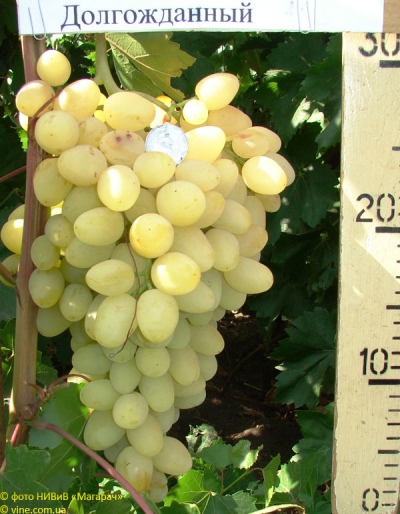
- Authors: Krainov Viktor Nikolaevich
- Appointment: dining room
- Berry color: transparent white
- Taste: harmonious
- With bones: No
- Ripening period: very early
- Ripening period, days: 105
- Frost resistance, ° C: 23
- Bunch weight, g: 700-1000
- Flower type: bisexual
The Long-awaited grape is a hybrid variety, whose name not only speaks for itself, but also fully justifies it. It could be attributed to kishmish, but bones are still found in it. If not for this annoying fact, the winegrowers in the collection would have the largest raisins.
Breeding history
The table variety appeared in the current millennium, its homeland is Novocherkassk. It was there that amateur breeder V.N.Krainov received it as a result of crossing the varieties Talisman and Radiant Kishmish, which have many remarkable qualities. The long-awaited took from the parent varieties all the best - great taste, high yield, early ripening, excellent endurance and frost resistance.
Geography of distribution
The long-awaited one has become widespread throughout Russia, where the vine is grown - from the mild climate of the Black Sea coast to Siberia, the Urals and the Far East.
Description
The long-awaited grows in a rather large bush, grafts well to other varieties and at the same time serves as an excellent stock, which makes it possible for gardeners to increase the assortment in a limited area. Viability allows it to propagate well, and all the cuttings take root well. The low demand for SAT (the sum of active temperatures) contributes to the excellent ripening of shoots to complete lignification in a short summer.
Ripening period
The long-awaited table grape belongs to the very early varieties - its fruits ripen successfully in 105 days from the beginning of the growing season, and in August they already delight the owners with a delicious berry.
Bunches
Large medium-friable clusters of regular pointed conical shape increase the mass of 700-1000 grams, but this is not the limit. Good conditions and adherence to agricultural technology allow you to grow brushes weighing up to 1700 grams. The decorative indicators are extremely high - an elegant shape, a radiant color, iridescent undertones can serve as a decorative design for a garden. No peas.
Berries
A transparent white large berry with a light green tint of a papillary shape acquires amber transparency when it reaches technical ripeness. The berry weighs 10-12 grams, the flesh is medium-dense, the skin is thin, eaten and almost imperceptible during the meal. The sugar content is 17-22%, the acidity is 7-8 g / l. Bones are rare and almost all of them are in a rudimentary state.
Taste
Tasters give a high assessment to the harmonious sweet, with a slight sourness, taste of the Long-awaited - 4.5 points. The variety is characterized by the absence of a tart aftertaste.
Yield
The variety shows good yield results - 10-12 kilograms per bush.


Growing features
The use of correct agricultural techniques, adherence to planting technology will certainly delight the gardener with the successful cultivation of the Long-awaited with the help of cuttings, grafts, seedlings.
Landing
Planting seedlings in the southern regions is possible in spring and autumn, in colder areas it is recommended to carry it out in the spring, at the end of April. Experienced growers, before planting, cover the roots of the seedlings with a talker made of mullein, clay, water, diluting the mixture to the consistency of liquid sour cream.
Plants need sunny areas that are well protected from winds and drafts and rich in humus, nutritious, loose soil. In no case should the roots come into contact with groundwater. If there is such a problem, and there is no choice of places for planting, drainage ditches should be drawn along the boundaries of the site.

Pollination
The long-awaited bloom in mid-June with bisexual flowers and does not need additional pollination.
Pruning
A similar procedure is required. Autumn is the time of long pruning, when 6-8 eyes are left on each of 20-25 shoots. During the spring, damaged and non-viable shoots are removed. Throughout the season, pinching is mandatory to avoid thickening of the bush and for better ventilation.

Watering
The variety does not need abundant watering, this is done only after planting and during ripening.


Top dressing
Medium-growing bushes absorb less nutrients than powerful vines of vigorous varieties, so feeding is carried out on a smaller scale. In late May and early June, each bush is fertilized with wood ash, introducing it into the soil at the root. Before flowering, the plant needs complex fertilizers, and in the fall, phosphorus-containing components are added.
Frost resistance and the need for shelter
The beauty of the hybrid is that it is frost-resistant, withstands up to -23 degrees. However, this does not mean that he copes with wintering on his own, without human help. Shelter in a cold climatic zone is mandatory for him, and young annual shoots are protected under any conditions.
In the fall, after disposal of the litter, the bushes are spud, the vine is removed from the supports, bent down, covered with earth, spruce branches, sawdust, and covered with agrofibre on top.

Diseases and pests
The hybrid has good resistance to fungal diseases, however, there is a danger of mildew and oidium damage - score 3-3.5. As a preventive measure, treatment with fungicides or a solution of copper sulfate is necessary. The long-awaited one successfully resists the attack of grape mites, but cases of wasps have been known, although in general, if there are other varieties in the neighborhood, they will give preference to them.

If a grape is exposed to any disease or insect, this always affects its appearance.
Storage
The harvest is stored for a long time in cool rooms with sufficient humidity. In the refrigerator, the bunches of the Long-awaited can withstand up to 7 months and retain their presentation.











































































